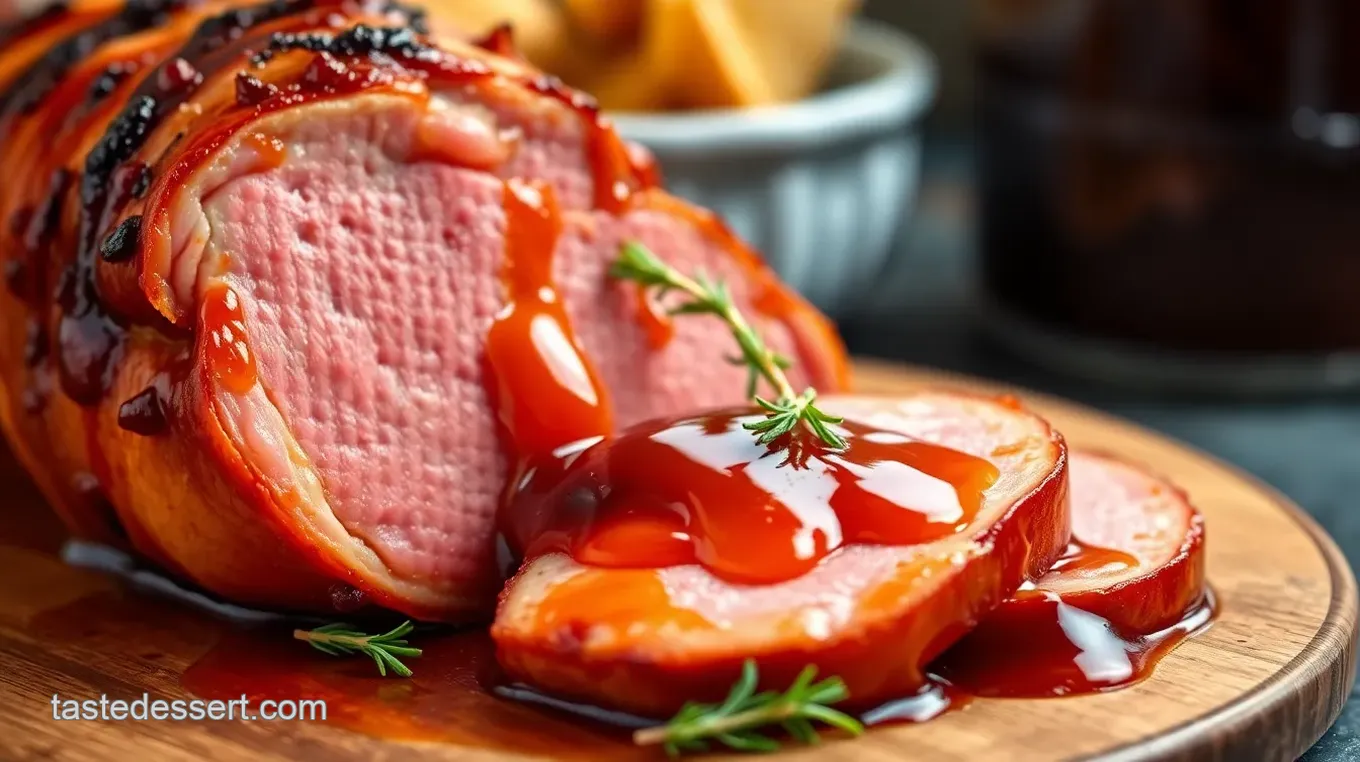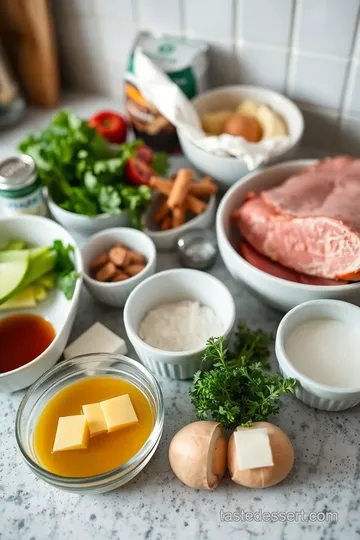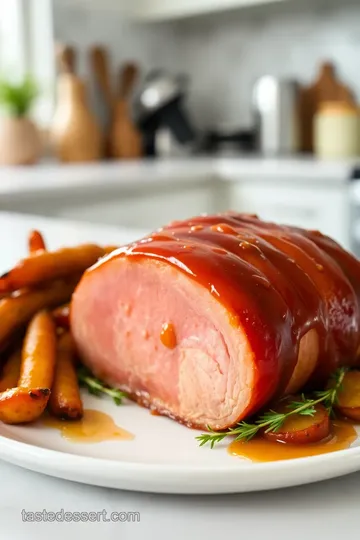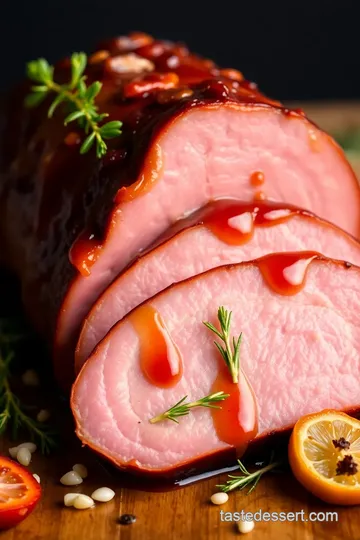Baked Gammon with Sweet Glaze
Looking for the ultimate Sunday centerpiece? My Baked Gammon with Sweet Glaze is not only easy & tasty but also brings warm memories from grandma’s kitchen! Follow my tips for the tastiest results.

- Loving the Tradition: A Sweet Glazed Gammon Recipe
- Where It All Began
- Getting Started: The Basics
- What Makes It Special
- Transition to Ingredients
- Your Go-To Essential Ingredients Guide
- Mastering the Art of Cooking: Professional Techniques You Need
- Unlocking the Secrets of Baked Gammon with Sweet Glaze - Easy & Tasty
- Recipe Card
Loving the Tradition: A Sweet Glazed Gammon Recipe
Oh my gosh, can we take a moment to talk about how food pulls us together during special occasions? i remember the first time i made baked gammon with sweet glaze - easy & tasty for a holiday dinner.
Picture this: the aroma wafting through the house, the family gathered around the table, and every single bite making folks close their eyes in bliss.
Seriously, that’s what life’s about, right? finding joy in shared meals.
So, if you're wondering what to whip up for your next family gathering or festive celebration, this savory yet sweet glazed ham recipe is a total game changer.
It’s one of those dishes that makes you look like a master chef, even if you’re a beginner. trust me, anyone can impress their guests with this showstopper on the table!
Where It All Began
Baked gammon has roots deep in british cuisine , where it’s been a holiday staple for ages. it's the kind of dish that recalls cozy winter dinners and festive gatherings.
This is not just any ham; we’re talking about a lovingly roasted gammon joint with a glaze that’s straight outta flavor heaven.
And what’s not to love? tender, juicy meat with a sweet, caramelized crust that makes each slice burst with flavor.
Did you know that gammon is actually pork that comes from the hind leg of a pig? it’s typically cured, and when baked, transforms into a delicious centerpiece that looks as good as it tastes.
Plus, it’s an easy holiday recipe that won't keep you in the kitchen all day!
Getting Started: The Basics
Alright, let’s break down the nitty-gritty. this recipe takes about 2 hours from start to finish, including prep, cooking, and resting times.
You’ll be spending about 15 minutes gathering your ingredients and about 1 hour and 15 minutes letting it all roast to perfection.
And don’t worry! it's super easy. even if you've never cooked a ham before, this one is for you.
For around $25, you can serve 8-10 people with this tender ham joint . talk about giving you bank for your buck! with the holidays around the corner, this dish is perfect for those larger family dinners, and trust me, everyone will want seconds.
What Makes It Special
Now, let’s talk benefits. this succulent gammon dish isn’t just pretty – it’s also got some serious health perks. gammon is packed with protein, and when glazed with honey and mustard, it’s a delightful balance of sweet and savory.
You get those flavorful ham dishes that are not just delicious but also somewhat nutritious.
Plus, it’s such a versatile dish. whether it's easter, thanksgiving, or just a cozy family dinner, this gammon roast is sure to steal the spotlight.
It’s not just about the flavor; it’s about creating memories.
Oh, and can i mention leftovers? you might have some, but that’ll just lead to even better meals. think sandwiches with leftover gammon or maybe tossing it in a salad.
The world is your oyster!
Transition to Ingredients
Now that you’re hopefully as excited about this sweet glazed gammon as i am, let’s dive into what you’ll need to bring this recipe to life.
Grab your apron; it’s going to be a fun ride!
Here’s the ingredient list for our easy ham recipe , and trust me, you’ll be so glad you made this dish!

Your Go-To Essential Ingredients Guide
Alright, let’s dive into the world of flavors, shall we? if you want your baked gammon with sweet glaze - easy & tasty to shine at your next family dinner or festive gathering, knowing the right ingredients is key! let’s break this down into bite-sized chunks.
Premium Core Components
First up, let’s talk about the premium components you need. for the gammon , aim for a 4-5 lb (1.
8-2.3 kg) joint. keep an eye out for the color; it should be a nice rosy pink. don’t forget to inspect the packaging for freshness dates.
The smell should be subtly meaty, without any funky vibes.
For storage, stick it in the fridge, wrapped up tight. Gammon can last a week or two if stored right—don't be that person who= lets great meat go bad! Pro tip: if you can find a butcher who knows their stuff, they can help you pick a great piece!
And let’s not forget about that glaze! you’ll need ½ cup honey and ½ cup brown sugar . look for the darker brown sugar—it’s richer and will give you that delicious caramelized vibe.
Store your honey in a cool, dark cupboard, and it can last indefinitely!
Signature Seasoning Blend
Now let’s spice things up! when it comes to blending flavors, finding those essential spice combinations is crucial. for our gammon, you’re gonna want dijon mustard, black pepper , and maybe a hint of cinnamon if you’re feeling adventurous.
Those classic flavors marry together perfectly—trust me, your taste buds will thank you!
Don’t forget about herbs. if you love that herby freshness, think about throwing in some rosemary or thyme . these herbs pair brilliantly with the sweetness in your glaze and elevate those savory notes.
You could even sprinkle a bit of fresh parsley on top when serving—it’ll look pretty and taste fab.
Smart Substitutions
Oh gosh, life happens, right? say you’re out of dijon mustard. no biggie! you can substitute with yellow mustard or even some horseradish for an extra kick.
And if you're looking for a twist, try maple syrup instead of honey. it’s all about making it work for you!
If you're watching your carbs, you can swap out brown sugar for coconut sugar. and for a vegan touch, use agave syrup in your glaze.
It’ll make for an equally delicious holiday ham !
Kitchen Equipment Essentials
Now, let’s gear up for cooking! you’ll need a few must-have tools: a large pot for boiling your gammon, a roasting pan for that heavenly glaze, and a basting brush to make sure every bit is coated.
Make sure you have a meat thermometer handy; it’s the key to a perfectly cooked joint. you want to hit at least 145° f ( 63° c) inside.
Nobody wants dry meat, am i right?
And if you're in a tight spot, a baking sheet can work if you don’t have a roasting pan. Just line it with foil, and you’re good to go!
Wrapping It Up
With these tips and tricks in your back pocket, you're ready to tackle that succulent gammon dish that’s gonna be the star of your table.
From the easy ham recipe that’s perfect for holiday cooking to understanding how to check doneness with a meat thermometer, you're all set!
Now, let’s get to the juicy part—the cooking! keep those flavor combinations and substitutions in mind as we move on to the fun instructions for creating this sweet glazed gammon that’ll knock everyone’s socks off.
Grab your ingredients and let’s cook up a storm!
Mastering the Art of Cooking: Professional Techniques You Need
Cooking is art, science, and a bit of magic rolled into one. if you’ve ever tried whipping up a baked gammon with sweet glaze - easy & tasty but found yourself confused along the way, you're in good company.
Let’s break down some essential professional cooking methods that can elevate your culinary game, making not just ham, but any dish, shine at your family dinner table.
Essential Preparation Steps
Before you even think about turning on the oven, you’ve got to lay the groundwork. enter mise en place , a fancy french term meaning "everything in its place.
" it’s as simple as chopping all your veggies, measuring spices, and grabbing utensils before diving in. this prep will save you from the chaos of last-minute scrambling.
Then, there’s time management . cook smart, not hard! break down your tasks. for our baked gammon , you’ll simmer the joint while you prepare the glaze.
Hands occupied? perfect! multitasking is your friend here.
Don't forget about organization. Keep your workspace clean and decluttered; this will keep your focus sharp and prevent those “Where did I put that?” moments.
And safety first! Always use a meat thermometer —for our gammon, you want to hit 145° F ( 63° C) for optimal juiciness and safety.
Step-by-Step Process
Alright, let’s roll with the steps! Here are the clear instructions:
-
Simmer the gammon: get that beautiful piece of meat in a pot, with water covering it well. add in large broken pieces of onion and smashed garlic for flavor.
Bring it to a simmer, and then let it cook on low for about 1. 5 hours .
-
Whip up that glaze: while your gammon is cooking, combine honey, brown sugar , and dijon mustard in a saucepan.
Heat it just enough for the sugar to melt—about 5 to 7 minutes should do.
-
Oven Time! Preheat to 375° F ( 190° C), so it’s hot and ready for your gammon.
-
Glaze the meat: once the gammon is ready, let it cool a bit and score the surface in a diamond pattern.
Brush on that delicious glaze, making sure to have some fun with it.
-
Roast Away: Pop that glazed beauty in the oven for 30- 40 minutes , basting halfway through. Your goal is a gorgeous caramelized crust!
-
Check Doneness: Make sure to use that thermometer! The internal temp hits 145° F ( 63° C)? Boom! You’re golden.
-
Serve Wisely: Let it rest for 15 minutes before slicing. You won’t want to miss out on those juicy, tender slices.
Expert Techniques for Cooking Perfection
Now, let’s get into the nitty-gritty. want to avoid common mistakes? baste regularly to keep that glaze juicy and flavorful.
And don’t skimp on scoring—make those cuts deep enough to absorb that glaze goodness!
If you find your roast isn’t browning as desired, don’t panic! Give it a little more time in the oven. Maybe your oven temp isn’t even—rotate it if needed.
Success Strategies for Perfect Results
A few tips for a flawless experience:
-
Avoid overcooking! No one wants a dry gammon. Quick check-ins with your meat thermometer can save the day.
-
Quality assurance is key. A simple taste test of your glaze before slathering it on assures that everything is balanced in flavor.
-
Weekend prep? This dish can be made ahead! After cooking the gammon, let it cool, glaze it, then refrigerate. Reheat it in the oven just before serving.
-
Leftover ideas? Diced gammon adds a lovely touch to salads, omelets, or even sandwiches. It’s like a whole new meal just waiting for you.
Additional Information
Cooking can be a delightful adventure, especially when you’re creating dishes like this baked gammon with sweet glaze - easy & tasty .
Keep these techniques in your back pocket. from time management to expert troubleshooting, you’ll be ready for any culinary challenge, be it for the holidays or just a cozy dinner at home.
So, roll up those sleeves and get cooking! you’ve got this!

Unlocking the Secrets of Baked Gammon with Sweet Glaze - Easy & Tasty
So, let's dive into the delicious world of the baked gammon with sweet glaze - easy & tasty . if you’re looking for an impressive centerpiece for holiday cooking or family gatherings, you’ve stumbled upon a real gem.
We’re talking about succulent gammon that’s just bursting with flavor thanks to a magical blend of honey, brown sugar, and a hint of mustard.
I mean, what’s not to love? buckle up, because i’m about to share some pro tips & secrets that’ll make your gammon shine even brighter!
Pro Tips & Secrets
First things first, cooking gammon isn’t just tossing a lump of meat in the oven. here are some insider secrets.
When preparing, let your gammon soak in that flavorful water bath for about 1. 5 hours . trust me, it makes it super tender.
basting techniques are key too—don’t let that glaze go to waste! brush it on every 15 minutes during roasting and watch that magic unfold.
Now, if you’re looking to enhance that flavor, try adding a dash of cinnamon to your glaze. it adds a warm spice that’s totally comforting .
Another tip? use a meat thermometer! you’re aiming for at least 145° f ( 63° c) for the juiciest, perfect ham.
After all, nobody wants dry meat, am i right?
Perfect Presentation
Okay, let’s chat about presentation. nobody wants a lackluster dish on their dinner table. for a beautiful plate, score the gammon in a diamond pattern before glazing—it not only helps the flavor penetrate but looks fab too! once out of the oven, don’t forget to rest it for about 15 minutes .
This keeps all those tasty juices where they belong.
For garnish, a sprinkle of fresh herbs or some slices of oranges can elevate your dish, adding a pop of color.
Pair it with some bright veggies, and your plate will look like a masterpiece! seriously, how you serve this will make your guests say, “wow!”
Storage & Make-Ahead
If you’ve got leftovers – which, let’s be real, is the best part of any meal – store them right ! keep your leftover gammon in an airtight container in the fridge for up to 4 days .
It’s perfect for making sandwiches or adding to soups. if you want to keep it for longer, consider freezing it.
Just make sure to wrap it tightly. when you’re ready to reheat, pop it in the oven covered at 350° f ( 175° c) until warmed—no soggy gammon here!
Creative Variations
Don’t be afraid to get creative with your glazed ham recipe . you could swap that honey for maple syrup for a unique twist or throw in whiskey for an adult-only option.
Feeling spicy? add some cloves or star anise for a truly festive flavor. if you’re watching your sugar intake, opt for a diy glaze for ham using less sugar or honey.
There’s no wrong way to make this dish your own!
And hey, if you’re hosting a holiday gathering, why not consider seasonal twists? In summer, try a peach glaze. In winter, how about adding some cranberries for a tart kick?
Complete Nutrition Guide
Talking about nutrition, it’s good to know what you’re serving up. a slice (about 3 ounces) of your traditional glazed ham packs around 350 calories with a healthy dose of protein.
Just keep an eye on the sodium levels —ham can be a little salty, so pair it with lighter sides like a fresh salad or veggies.
Expert FAQ Solutions
Got questions? you’re not alone! some folks worry about making their gammon tender. simple! just remember the soaking step and score your meat well.
And if you're unsure about cooking times, always go with your thermometer—the magic wand of cooking!
If you want to impress your friends at gatherings, consider serving your sweet glazed gammon with homemade apple sauce. It’s a match made in heaven!
Closure
Wrapping things up, i hope you’re inspired to give this easy ham recipe a try. with tasty tricks up your sleeve, beautiful presentation tips, and a creative spin to keep things fresh, you’re all set for an unforgettable dish.
Whether for a festive gathering or just a cozy family dinner, this delicious holiday ham will steal the show. enjoy every juicy, savory bite—you deserve it! happy cooking, my friends!

Baked Gammon with Sweet Glaze Card

⚖️ Ingredients:
- 4-5 lbs (1.8-2.3 kg) gammon joint (bone-in or boneless)
- 1 large onion, quartered
- 2-3 cloves of garlic, smashed
- 1-2 bay leaves
- Water (enough to cover the gammon in pot)
- ½ cup (120 ml) honey
- ½ cup (100 g) brown sugar, packed
- 2 tablespoons Dijon mustard
- 1 teaspoon ground black pepper
- 1 teaspoon ground cinnamon (optional)
- 2 tablespoons apple cider vinegar (or orange juice for a sweeter flavor)
🥄 Instructions:
- Step 1: Place the gammon joint in a large pot and cover with water. Add onion, garlic, and bay leaves to the pot. Bring to a simmer over medium heat, then reduce to low and cook for about 1.5 hours.
- Step 2: In a small saucepan, combine honey, brown sugar, Dijon mustard, black pepper, cinnamon (if using), and apple cider vinegar. Heat over medium until sugar dissolves; stir to combine.
- Step 3: Preheat your oven to 375°F (190°C).
- Step 4: Remove the gammon from the pot and let it cool slightly. Score the surface in a diamond pattern with a sharp knife. Brush the glaze generously over the surface.
- Step 5: Place the gammon in a roasting pan and cover loosely with aluminum foil. Roast in the preheated oven for 30-40 minutes, removing foil halfway through and basting with additional glaze until golden and caramelized.
- Step 6: Use a meat thermometer to ensure the internal temperature reaches at least 145°F (63°C).
- Step 7: Let rest for 15 minutes before slicing. Serve warm.
Previous Recipe: How to Bake Chocolate Cake with Joyful Flavor: 10 Amazing Tips!
Next Recipe: How to Bake Chocolate Chip Cookies in 30 Minutes: My Family’s Favorite Recipe
